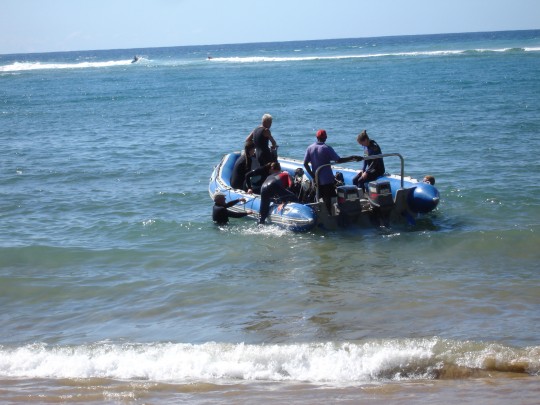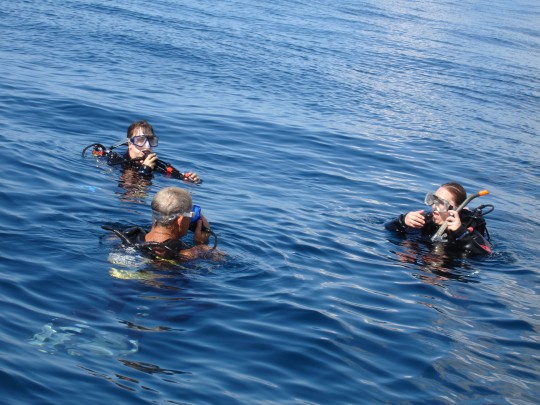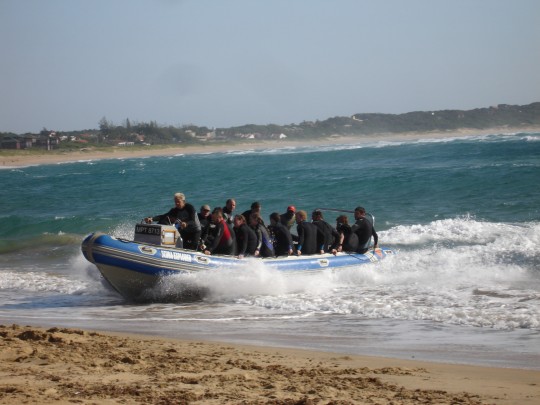There are divers around the world that will – and do – happily dive from all sorts of vessels. In some parts of the world diving takes place from reed rafts (Lake Malawi), from mokoros – similar to a hollowed out tree (some places in Mozambique), from canoes, jet skis, house boats (Lake Kariba), various hard boats and of course the most popular, rubber ducks. Their real name is semi rigid inflatables. People also use fold away inflatables with smaller motors in many places: these boats can be stored in your boot, inflated at the dive site, loose floor boards placed inside and a small outboard attached. All of this takes less than an hour and you are on your way to a dive site of your choice with a few buddies (only a few as they are small boats).
I will focus on the rubber ducks we use most often in South Africa, but most of these points apply to any type of vessel.
Much of the diving in South Africa and in many parts of Mozambique require a boat capable of taking 12 to 14 people and all their gear, and then being rugged enough to launch and return through rough surf, and then be able to withstand beaching. A dive boat with 10 divers, 10 sets of gear and all the safety gear can weigh around two tons. That’s a lot of weight when the boat is slammed onto the beach at a speed suitable to ensure it comes to a stop high enough out of the water so you can just step off.

There is a lot to a dive boat, irrespective of whether it is a hard boat, a huge live aboard or a rubber duck. They require maintenance, and this can easily be managed if divers just have a little respect for them. Sure, the owner/operator must be held responsible, but with a little attention to the small details they offer us as divers years of good service.
It goes without saying that you expect a boat to have all the necessary safety gear, life jackets, flares, first aid kit, emergency oxygen, tool kit etc. I believe you will find most operators following the law here. Just as motor cars need to pass a roadworthy test, so boats need a seaworthy inspection and to pass this there is a list of requirements to be met. Having met this, passed the inspection, mostoperators will usually comply, as a rule.
Be gentle
Almost all boats have a wooden or fibreglass deck. Tossing your gear around and dumping weight belts on the boat, all contribute to the damage sustained by operators, but often it is your foot, your regulator or pressure gauge or perhaps your expensive air integrated dive computer that gets damaged when someone tosses their weight belt on board. Always hand things up to the people on the boat, never toss them up.
Pontoons are tough and designed to withstand much abuse. However, the wire ring you used to fix your zip, the sharp edged cable ties on you gear, the rough edges of your cylinder boot, and your dive knife, all pose danger for the pontoon. Think about the pontoon when you drag your gear on and off the boat, and think about the grooves created by dragging kit over the pontoon time and time again.
The console up front usually houses all the electrical connections and switches for the boat’s electrical system, and just shoving all your belongings in there is not the way to go. Ask the skipper where you should put things as he/she will have a place for everything.
All skippers have a specific place for everything on their boats. Respect this as it makes it easier for the skipper to produce things for you on demand when you want them. Another important consideration is that it may be the place the first aid kit is kept and in an emergency it is annoying to a skipper to find their first aid kit has been replaced with a camera, cell phone and towel.
Loading the boat
When your gear is being loaded:
- make sure you know where on the boat it is placed;
- make sure you place your fins close by;
- make sure your mask is there, either around your neck or in your fin (not on your head!);
- make sure your weight belt is loaded and that you can recognise it;
- and make sure you are kitted up and dressed ready to go when the boat leaves

Launch times
Respect the launch times! You may be doing one dive and have all day, but there are others doing the next dive that are going to run late if you hold the boat up.
When the boat leaves the beach or the jetty, stay seated, feet in the foot straps and hold on tight. This is not the time to be walking around the boat passing the skipper your keys, glasses and cameras. This unbalances the boat and makes it harder to negotiate the surf or other boat traffic. This is also the time when you would fall off and blame the skipper.
Before the dive
At the dive site, follow the basic rule: be opposite your gear, and don’t expect heavy dive gear to be passed around on the boat. When the skipper comes round to put your gear on your back, make sure you are ready with the straps extended, the clips done or undone as you require, your air turned on, and that you have your weight belt on, right hand release. Don’t expect the skipper to do everything for you as it’s unfair on all the other divers who kit themselves up and are ready to roll two minutes after the boat stops, only to have to wait 10 minutes for you because you are on the wrong side of the boat, can’t find your mask, forgot what colour your fins are, etc. Finally, when you are all ready, the skipper will count you down. Go on the word “go” (or whatever word the skipper tells you to roll over on) – if you hesitate stay on the boat, or you may land on the person next to you and injure them.

On the surface
At the end of the dive, signal you are OK once on the surface, then watch the boat as it approaches you. Don’t stick your face in the water and expect the boat not to run you over. Hand up your weight belt, camera, torch etc when the boat is alongside, but make sure the skipper has a firm grip on it before you release it. Just shoving it in his or her direction is no guarantee that the item won’t end up on the bottom.
When you hand your BCD and cylinder up, make sure your BCD has some air, but is not totally inflated. Make sure you give it a shove from the bottom and most of all, if possible give the skipper a chance to tie it down before you demand a hand-up. Once on the boat take care of your own kit, roll up your SMB, tuck your regulators away, and place your fins and mask out of harm’s way, preferably inside or close to your BCD. Make space for others to get into the boat, or better still, give them a hand. Don’t scatter your gear around, as a deck littered with fins, masks and cameras becomes a difficult place for a skipper to work and things will get broken… Your things!
After the dive
At the end of the dive make sure you collect all your gear as soon as possible. The boat may need to be loaded for the next launch and if you first get undressed, have a snack and then stroll over to the boat, it is likely your gear will be mixed up with the next load of divers’ gear.
Imagine this…
The boat arrives at the dive site, a few people are sitting at opposite ends of the boat to their kit, gear is passed around and a mask is crushed, someone starts bellowing, someone else drops his mask in the water as they are trying to rinse it while fully kitted up (rinse your mask first), they start whining, someone else who does not service their gear has a faulty regulator, they swear blind it was okay on the beach but you can see clearly the hose has been torn for months and is badly cracked, someone says “oops, I forgot my fins in the car”, so the skipper hauls out all the spares he has, gets everyone sorted out and you all roll back into the water.
Someone hesitates, and lands on another diver, gashing their head open with a cylinder, so the diver is hauled out of the water. The gash in their head requires bandaging, yet at the same time five hands appear next to the boat all demanding cameras. The skipper usees all his psychic skill to ensure everyone gets their own camera, then observes that a few divers are struggling to descend. The skipper hauls out the extra weights, sorts them out and down the divers go, all but one – ”I forgot to put my weight belt on!” So they get sorted out and descend.
Twenty minutes into the dive someone pops out of the water like a cork, and gets hauled out of the water. As a safety measure the skipper administers oxygen. Their buddy surfaces a few minutes later, swims up to the boat and tosses their weight belt on board, landing on their buddies head.
These thing happen, fortunately very very seldom, but every diver wants to have a good time, a good dive and a pleasant boat trip, and if we all follow the instructions of the skipper, the Divemaster or Instructor and basic dive safely protocol, these things will not happen. Plan your dive and dive your plan.
On a typical day a skipper can easily see between 20 and 40 different people. It is not possible for the skipper to remember what your weight belt looks like, what colour your fins were and what gear you are using, so make it easier by being responsible for your gear. If you have rental gear it will often be numbered: remember the numbers, remember the colour of your fins and mask, so keeping all your kit together in one spot on the boat will make this easier.
Driving a boat is easy?
Boats look really easy to drive: a steering wheel, a control box that puts the boat in gear and accelerates all at the same time, no clutch, no hand brake, no turn signals, wide open expanse of ocean to drive in – it stands to reason it must be really easy. And it is: on a nice calm day with flat seas, no wind, and no swell, it is real easy to place a boat precisely in the spot you want it, run it up next to the jetty and come to a stop millimeters from the side.

But on a day when the wind is humping, there is a big swell and lots of other boat traffic it becomes a little more challenging. If you are asked by the skipper to sit down, keep your feet in the foot straps and hold on, then do so, as he/she probably knows better. A skipper doing surf launches needs to concentrate only on the boat while launching and beaching. Don’t walk around, shout at them or hand them things as they are reading the water, the swell, and the gap that is forming out at the back line and making a decision to go or not to go. Your safety is their primary concern. Once committed to the break in the swells it is not easy to change your mind.

In a nutshell…
Pay attention to the boat briefing as the skipper has the responsibility for your safety. Make it easy for him to keep you safe. In an emergency you will expect the skipper to produce a first aid kit in a flash, produce pure oxygen in an instant and radio for help in an extreme emergency. This will happen, and your emergency will be dealt with expertly, if the skipper finds his first aid kit accessible, his oxygen set at hand and his radio functioning. But if you shoved your bag in the console and ripped wires out of the radio, dumped your personal bag of clothing on the first aid kit, moved the oxygen somewhere else on the boat to make space for your camer – when these things happen all they do is delay the reaction time of the help that you the diver need.
Pay attention to the dive briefing. Chances are the dive master has been there many times before and is speaking from experience. If you are unsure of something, ask – there are no stupid questions, and the only stupid mistake is not asking if you are unsure.
Many divers have done hundreds and in some cases thousands of dives, all incident free, all enjoyable and all conducted safely and this is largely due to their own exceptional skills, and exceptional skills held by skippers and divemaster coupled to a level of boat etiquette we all have or should have. This is just one more reason to dive, to enjoy the wonders the ocean never fails to deliver.








Comments are closed.